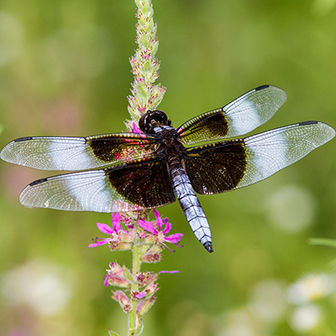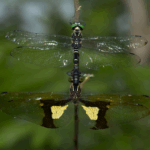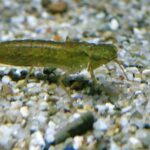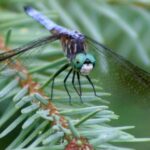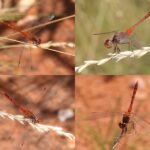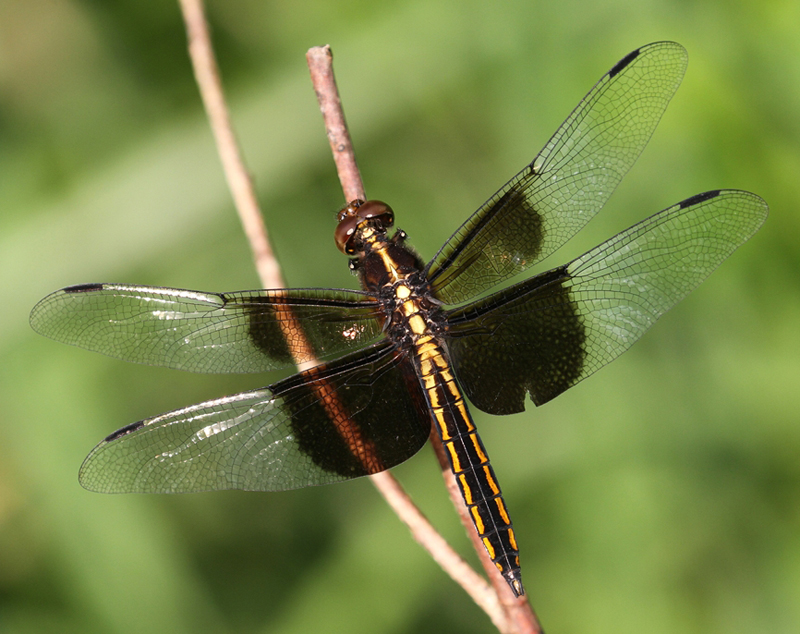
There is no white coloration in the female’s wings. Both male and female widow skimmers are often seen far from water in grasslands and along roads. At water, they fly from a few inches to about six feet above the water’s surface. Males defend a territory from other dragonflies of their own and other species.
The widow skimmer (Libellula luctuosa) is one of the group of dragonflies known as king skimmers. The nymphs live in the water, molting and growing until they are ready to emerge from the water and then molting a final time to reveal their wings.
Widow skimmers have large bulky bodies, with large heads. Adults have a steely blue body area but juveniles are yellow with brown stripes.Eyes are also large and close together meeting in the middle of the head.They have three pairs of legs. Legs are black in color. They have two pairs of wings: forewings and hindwings. Wings of both sexes are marked with prominent black basal bands. They keep their wings extended over their bodies. Adult males develop broad white spots at midwing as they mature. The abdomen measures 24–32 mm.They also have a slight white hue on their abdomen and thorax.
Habitat
This species is found commonly in muddy substrates, or still bodies of waters such as ponds, lakes, streams, and creeks.
This species is common throughout United States and southeastern Canada but not in Great Basin and Rocky Mountains area. It is usually found at ponds, lakes, marshes, and some few slow streams. It is common and widely distributed throughout Wisconsin.
Scientific Name:Libellula luctuosa
Family:Libellulidae (skimmers) in the order Odonata (dragonflies and damselflies)
Description:The widow skimmer has distinctive dark wing markings that seem like mourning garb. Females and young males usually have brownish wingtips, and the abdomen has a brown stripe down the center flanked by two yellow stripes. Mature males have white areas in the center of their wings, beside the dark patches.
Distinguishing Characteristics:
The widow skimmer is easily identified by its wings, which have large dark patches on the basal half. With the shoulders and abdomen white, the black male has white and black bands on its wings. Lighter in the color than the male, the female’s wings have brown tips and brown basal wing patches. The female also has yellow stripes going down its body. The colors tend to darken with age. The widow skimmer’s body seems larger due to the wings being large for the body. The length of the body varies from 1.7 to 2.0 inches.
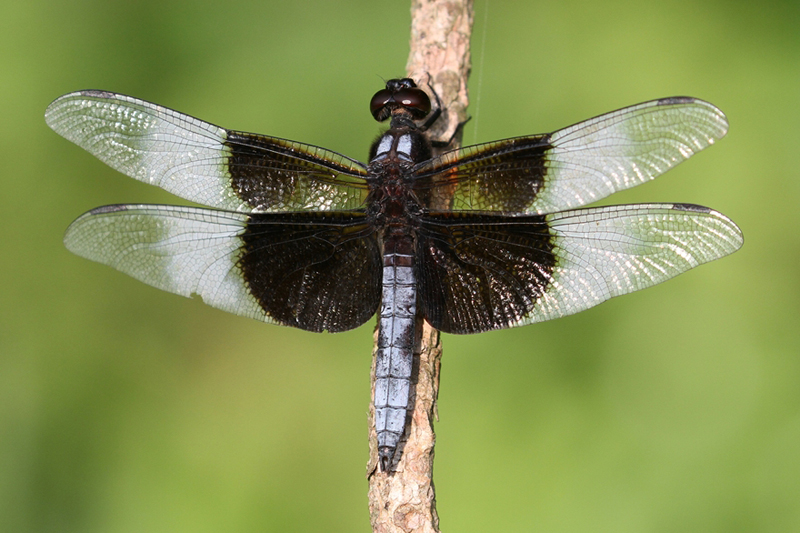
Mature males have a large basal area of brown on each of the four wings, and each wing also has a whitish area roughly at the middle. Their brown bodies become increasingly pruinose (whitish) as they get older.
Females and immature males have the same brown wing bands as the mature males, but not the whitish areas. Wings usually have a brown tip. A dorsal view of the abdomen shows a brown band at center with a yellow stripe running along each side.
Widow Skimmers live near warm waters. The water source could be a pond, marsh, small lake, or lagoon. Water is necessary for a skimmer’s first life stage, and adults are often found near wet places, too. Transparent wings on males and females have similar thick black bands on either side, but males have a long abdomen that is light powdery blue, but females are yellow and black. Come mating season, adults have no trouble pairing off despite these color differences. Unlike some other species where males guard egg-laying females, Widow Skimmer males leave the female by herself, ‘widowing’ her as she lays her eggs just under the surface of the water.
Larval dragonflies are called naiads. They usually have large jaws and look more like a squat bug than an elegant dragonfly. They live underwater and eat smaller aquatic insects including other naiads sharing the same pond. They eventually leave the water and begin crawling on land to find a shrub or low plant to cling to. They molt again and emerge as adults in late spring or summer, depending on the climate. Adults feed on small insects and can be found resting on shrubs, reeds, and other short plants.
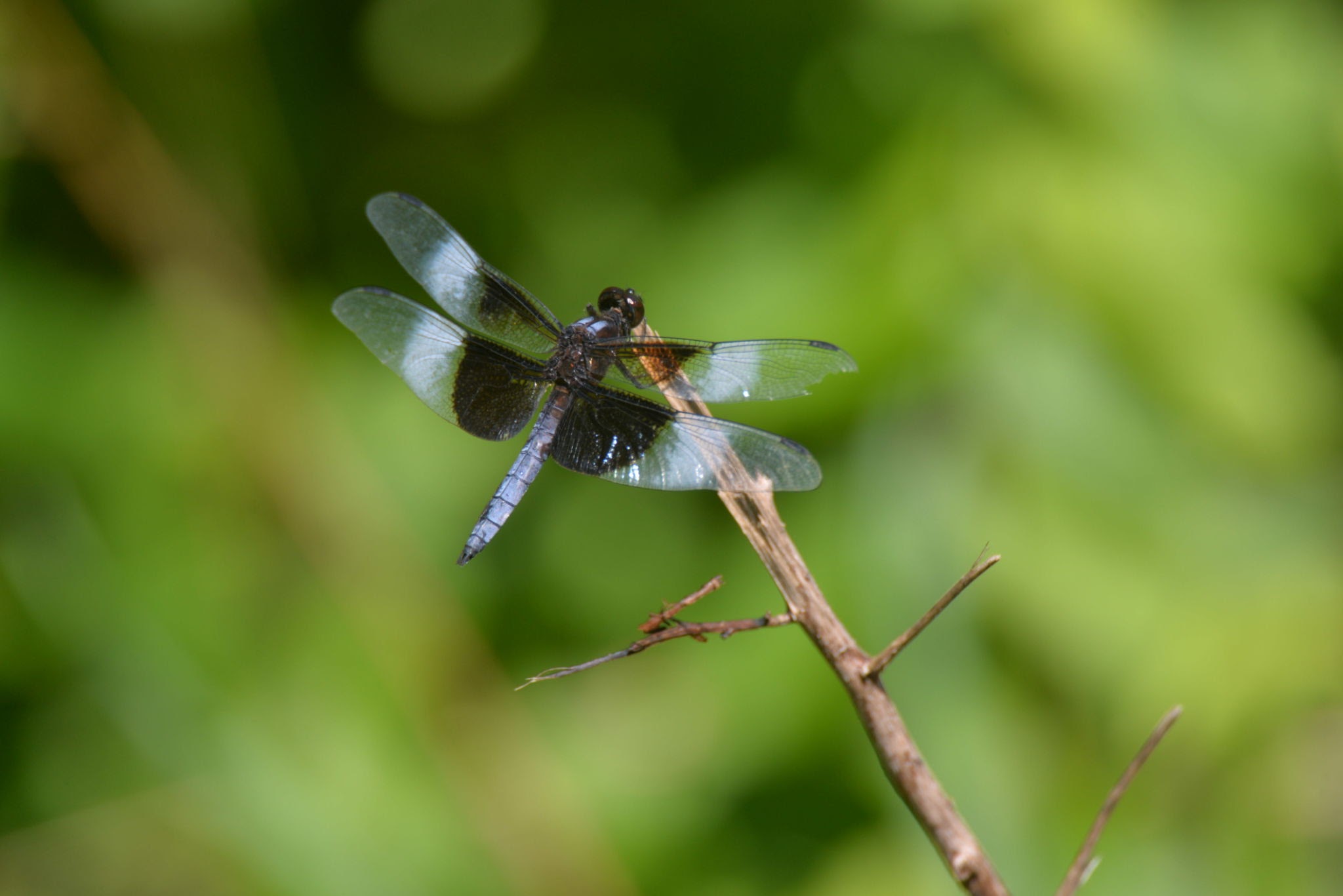
BEHAVIORS
Both male and female widow skimmers are often seen far from water in grasslands and along roads. At water, they fly from a few inches to about six feet above the water’s surface. Males defend a territory from other dragonflies of their own and other species. They may have a group territory where the dominant male is most likely to mate. Mating occurs quickly, usually in flight. Females lay eggs by flicking them on open water or releasing them below the abdomen and then tapping open water with the tip of the abdomen causing them to drop into water. Adults may live about 43 days after reaching maturity. Adults catch insects in flight. Nymphs eat insects and a variety of other small animals. This species is typically active from May through October.
widow skimmer interesting facts
Here are some interesting facts about widow skimmers (Libellula luctuosa), a type of dragonfly that is common in the United States and parts of Canada:
Appearance
Widow skimmers have large wings for their body size, which can make their bodies look larger. Males are black with white shoulders and abdomen, and have white and black bands on their wings. Females are lighter in color, with brown tips and basal patches on their wings, and yellow stripes on their bodies. Their wings have large dark patches on the basal half, which some say resemble mourning garb.
Behavior
Widow skimmers are predators that hunt other insects, such as mosquitoes, using their legs and fangs. They are also known for their unique flying abilities, which include being able to move and rotate each wing independently, fly backwards, and hover.
Reproduction
When widow skimmers reproduce, they mate near ponds and fly in tandem to form a wheel or heart shape before transferring sperm. Unlike other dragonfly species, the male then leaves the female alone to lay her eggs, which she flicks onto open water or releases below her abdomen. This process is known as “widowing”.
Habitat
Widow skimmers are commonly found in still bodies of water, such as ponds, lakes, streams, and creeks, as well as muddy substrates.
Name
The Latin species name for the widow skimmer, luctuosa, means “sorrowful or mournful,” which may be a reference to the appearance of the wings, which some say look like mourning crepe.

